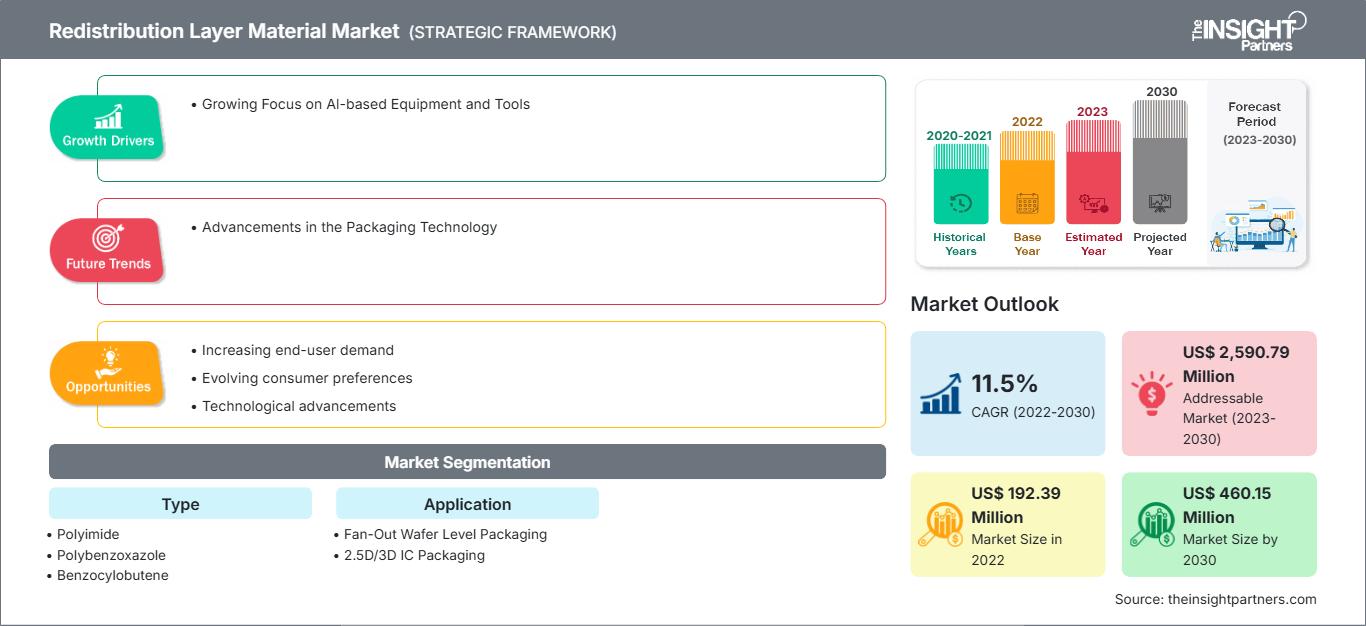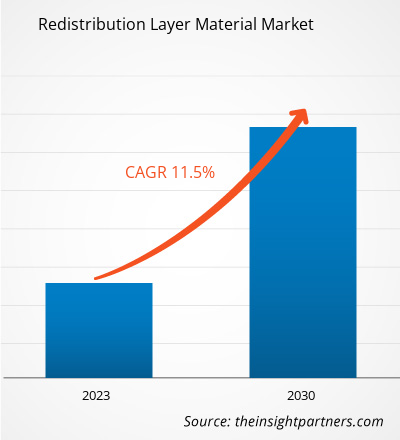[연구 보고서] 재배선층 소재 시장 규모는 2022년 1억 9,239만 달러에서 2030년 4억 6,015만 달러로 성장할 것으로 예상되며, 2022년부터 2030년까지 연평균 성장률 11.5%를 기록할 것으로 예상됩니다.
시장 분석 및 분석가 의견:
첨단 패키징 공정은 다이 레벨에서 시작되며, 입출력(I/O) 밀도를 저하시키지 않으면서 다이 크기를 줄이는 것을 목표로 합니다. 여러 다른 신생 패키징 기술들이 소자의 이종 집적화에 중요한 역할을 합니다. 웨이퍼 레벨 팬아웃 패키징(WLFO)은 포괄적인 패키징 공정으로 부상한 주요 패키징 기술 중 하나입니다. WLFO 공정은 이전에는 단일 다이 설계, 즉 재구성된 웨이퍼의 한쪽 면에 단일 재배선층(RDL)만 사용했습니다. RDL은 고급 웨이퍼 패키징에서 중요한 단계입니다. RDL은 I/O 레이아웃을 재라우팅하여 더 많은 I/O를 구현할 수 있도록 합니다. 높은 I/O 밀도는 일반적으로 더 나은 전기적 성능을 제공하는데, 출력이 많을수록 다이 간 전기 신호가 더 빨라지고 전기 단락으로 인한 위험이 최소화되기 때문입니다. 또한, 높은 I/O 밀도는 패키지가 동시에 더 나은 성능을 달성할 수 있도록 합니다. 더욱이, 아시아의 글로벌 제조 허브로서의 전략적 위치와 경쟁력 있는 생산 비용은 공급망 최적화를 모색하는 다국적 기업들을 유치하는 데 기여했습니다. 이는 다양한 공급업체와 제조업체가 이 지역에 입지를 구축하면서 재배선층(RDL) 재료 시장을 위한 강력한 생태계를 구축했습니다. 이러한 요인은 글로벌 재배선층(RDL) 재료 시장 성장을 크게 촉진하고 있습니다.
성장 동력 및 과제:
재배선층(RDL) 재료는 AI 기기의 복잡성 증가에 대응하기 위해 필수적인 반도체 패키지 소형화를 가능하게 하는 핵심 요소입니다. 더욱 발전된 AI 기능을 위해서는 소형화되고 고밀도 집적된 하드웨어 구성 요소의 개발이 필수적입니다. AI 시스템이 더욱 정교해짐에 따라 더 작고 효율적인 부품에 대한 수요가 증가하고 있습니다. 따라서 AI 기반 장비 및 도구에 대한 수요 증가는 재분배층 소재 시장을 견인하고 있습니다. 더욱이, 글로벌 재분배층 소재 시장은 자동차와 통신이라는 두 핵심 산업의 수요 급증에 힘입어 상당한 성장을 경험하고 있습니다. 자동차 산업의 생산 수요 증가는 시장 성장을 촉진합니다. ISEAS-유소프 이샤크 연구소에 따르면, 동남아시아는 중요한 자동차 생산 기지입니다. 동남아시아는 세계 7위의 자동차 제조 허브이며 2021년에는 350만 대의 자동차를 생산했습니다. 그러나 원자재 가격 변동은 글로벌 재분배층 소재 시장의 성장에 심각한 난관을 초래합니다. 이러한 가격 변동은 산업에 상당한 영향을 미쳐 생산 비용, 가격 책정 전략, 그리고 전반적인 시장 안정성에 영향을 미칠 수 있습니다. 핵심 문제 중 하나는 수입 원자재에 대한 의존도입니다. 특수 폴리머, 금속, 화학 물질과 같은 재분배층 소재의 필수 구성 요소는 종종 해외 공급업체로부터 조달됩니다.
이 보고서의 일부, 국가 수준 분석, Excel 데이터 팩을 포함하여 모든 보고서에 대한 사용자 정의를 무료로 받을 수 있을 뿐만 아니라 스타트업 및 대학을 위한 훌륭한 제안 및 할인을 이용할 수 있습니다
재분배층 소재 시장: 전략적 통찰력

- 이 보고서의 주요 주요 시장 동향을 확인하세요.이 무료 샘플에는 시장 동향부터 추정 및 예측에 이르기까지 데이터 분석이 포함됩니다.
보고서 세분화 및 범위:
글로벌 재배선층 소재 시장은 유형 및 응용 분야에 따라 두 가지 유형으로 나뉩니다. 유형에 따라 재배선층 소재 시장은 폴리이미드(PI), 폴리벤조옥사졸(PBO), 벤조사이클로부텐(BCB) 등으로 구분됩니다. 응용 분야에 따라 재배선층 소재 시장은 팬아웃 웨이퍼 레벨 패키징(FOWLP)과 2.5D/3D IC 패키징으로 구분됩니다. 지리적으로 시장은 북미(미국, 캐나다, 멕시코), 유럽(독일, 프랑스, 이탈리아, 영국, 러시아, 기타 유럽), 아시아 태평양(호주, 중국, 일본, 인도, 한국, 기타 아시아 태평양), 중동 및 아프리카(UAE, 사우디아라비아, 남아프리카, 기타 중동 및 아프리카), 남아프리카 및 기타 아시아 태평양으로 분류됩니다. 중앙아메리카(브라질, 아르헨티나, 기타 남미 및 중앙아메리카).
세분화 분석:
재분배층 소재 시장은 유형에 따라 폴리이미드(PI), 폴리벤조옥사졸(PBO), 벤조사이클로부텐(BCB) 등으로 세분화됩니다. 폴리이미드(PI) 부문은 2022년에 가장 큰 시장 점유율을 기록했습니다. 폴리이미드는 높은 용융 점도를 가진 폴리머 기반 열가소성 수지이며, 성형 부품 성형 시 더 높은 압력이 필요합니다. 폴리이미드는 우수한 내화학성, 높은 기계적 강도, 높은 열 안정성, 그리고 탁월한 전기적 특성을 제공합니다. IC 패키징 공정에서 폴리이미드는 고온 접착제, 기계적 응력 완충재, 그리고 미세 회로를 지지하는 필름으로 사용됩니다. 폴리이미드를 사용할 때 유일한 단점은 높은 경화 온도인 반면, 패키징 공정은 낮은 경화 온도를 요구한다는 점입니다. 따라서 여러 소재 공급업체는 더 낮은 경화 온도의 폴리이미드 공급에 주력해 왔습니다. PI는 모든 플립칩 웨이퍼 범핑 및 WLP 애플리케이션에 주로 사용됩니다. 재배선층 소재 시장은 응용 분야별로 팬아웃 웨이퍼 레벨 패키징(FOWLP)과 2.5D/3D IC 패키징(고대역폭 메모리(HBM), 다중 칩 집적, 패키지 온 패키지(FOPOP) 등)으로 구분됩니다. 2.5D/3D IC 패키징 부문의 재배선층 소재 시장 점유율은 2022년에 두드러졌습니다. 차세대 실리콘 노드에서 리소그래피 단계 및 웨이퍼 공정 비용 증가로 인해 업계는 전자 소자의 성능과 기능을 개선하기 위한 대안을 모색하고 있습니다. 또한, 로직, 메모리, RF, 센서와 같은 다양한 기술을 소형 폼팩터에 통합해야 할 필요성으로 인해 업계는 3D 집적을 솔루션으로 선택하고 있습니다.
지역 분석:
재분배층 소재 시장은 북미, 유럽, 아시아 태평양, 중남미, 중동 및 아프리카의 5개 주요 지역으로 구분됩니다. 아시아 태평양 지역은 2022년에 약 1억 5천만 달러를 차지한 글로벌 재분배층 소재 시장을 장악했습니다.북미 지역도 주요 기여 지역으로, 상당한 글로벌 재분배층 소재 시장 점유율을 보유하고 있습니다.북미 재분배층 소재 시장은 2030년까지 6천만 달러를 넘어설 것으로 예상됩니다.유럽은 2022년부터 2030년까지 10% 이상의 상당한 CAGR을 기록할 것으로 예상됩니다.국가별로 아시아 태평양 재분배층 소재 시장은 호주, 중국, 인도, 일본, 한국 및 기타 아시아 태평양 지역으로 세분화됩니다.시장은 자동차 및 통신 산업의 재분배층 소재에 대한 수요 증가에 의해 주도됩니다.대만이 이 지역 시장을 장악하고 있으며, 그 뒤를 중국, 한국, 일본, 베트남 등이 따릅니다.이 지역은 다양한 제조 산업이 존재하기 때문에 글로벌 제조 허브로 간주됩니다. 중국이 고숙련 제조 허브로 발전함에 따라 인도, 한국, 대만, 베트남과 같은 개발도상국은 저숙련 및 중숙련 제조 시설을 인접 국가로 이전하려는 여러 기업을 유치하고 있으며, 이는 인건비 절감으로 이어집니다.
산업 발전 및 미래 기회:
재분배층 소재 시장에서 활동하는 주요 업체들이 취한 다양한 계획은 다음과 같습니다.
- 2022년 8월, ASE Technology는 말레이시아 페낭에서 새로운 반도체 조립 및 테스트 시설 건립 기공식을 개최했습니다. ASE Malaysia(ASEM)의 새로운 시설은 바얀 레파스 자유산업지구에 위치하며, 982,000제곱피트(약 982,000제곱피트) 규모의 두 개의 건물(공장 4호 및 5호)로 구성됩니다.
- 2021년 7월, DuPont Mobility & 머티리얼즈(Materials)는 고성능 자동차 접착제 생산 능력을 확대하기 위해 독일과 스위스에 있는 자사 제조 시설에 500만 달러의 자본 및 운영 자원을 투자할 계획을 발표했습니다.
COVID-19 팬데믹의 영향:
COVID-19 팬데믹은 여러 국가의 거의 모든 산업에 악영향을 미쳤습니다. 북미, 유럽, 아시아 태평양(APAC), 남미 및 중미(SAM), 중동 및 아프리카(MEA) 지역의 봉쇄, 사업 중단, 여행 제한은 화학 및 소재 산업을 포함한 여러 산업의 성장을 저해했습니다. 제조 시설 폐쇄는 글로벌 공급망, 제조 활동, 납품 일정, 필수 및 비필수 제품 판매에 차질을 빚었습니다. 여러 기업이 2020년에 제품 배송 지연과 제품 판매 부진을 보고했습니다. 팬데믹으로 인한 경기 침체로 인해 소비자들은 구매 결정에 신중하고 까다로워졌습니다. 특히 개발도상국의 소비자들은 소득 감소와 불확실한 수익 전망으로 인해 비필수 제품 구매를 크게 줄였습니다. 많은 재분배층 소재 제조업체들이 팬데믹 초기 단계의 소비자 수요 감소로 인해 수익 감소를 보고했습니다. 그러나 2021년 말까지 많은 국가가 백신 접종을 완료했고, 각국 정부는 봉쇄 및 여행 금지 등 특정 규제 완화를 발표했습니다. 인구의 가처분소득 증가로 새 가구 구매 및 리모델링에 대한 관심이 높아져 재분배층 소재 수요가 급증했습니다. 이러한 모든 요인들이 여러 지역의 재분배층 소재 시장 성장을 촉진하고 있습니다.
재분배층 소재재분배층 소재 시장 지역별 통찰력
The Insight Partners의 분석가들은 예측 기간 동안 재분배층 소재 시장에 영향을 미치는 지역별 동향과 요인을 면밀히 분석했습니다. 이 섹션에서는 북미, 유럽, 아시아 태평양, 중동 및 아프리카, 그리고 중남미 지역의 재분배층 소재 시장 부문 및 지역별 현황도 다룹니다.
재분배층 소재 시장 보고서 범위
| 보고서 속성 | 세부 |
|---|---|
| 시장 규모 2022 | US$ 192.39 Million |
| 시장규모별 2030 | US$ 460.15 Million |
| 글로벌 CAGR (2022 - 2030) | 11.5% |
| 이전 데이터 | 2020-2021 |
| 예측 기간 | 2023-2030 |
| 다루는 세그먼트 |
By 유형
|
| 포함된 지역 및 국가 | 북미
|
| 시장 선도 기업 및 주요 회사 프로필 |
|
재분배 레이어 소재 시장 참여자 밀도: 비즈니스 역학에 미치는 영향 이해
재분배층 소재 시장은 소비자 선호도 변화, 기술 발전, 그리고 제품 이점에 대한 인식 제고 등의 요인으로 인한 최종 사용자 수요 증가에 힘입어 빠르게 성장하고 있습니다. 수요 증가에 따라 기업들은 제품 라인업을 확장하고, 소비자 니즈를 충족하기 위한 혁신을 추진하며, 새로운 트렌드를 적극 활용하고 있으며, 이는 시장 성장을 더욱 가속화하고 있습니다.

- 을 얻으세요 재분배층 소재 시장 주요 주요 플레이어 개요
경쟁 환경 및 주요 기업:
SK 하이닉스, 삼성전자, 인피니언 테크놀로지스, 듀폰 드 느무르, 후지필름 홀딩스, 앰코 테크놀로지, ASE 테크놀로지 홀딩스, NXP 반도체, JCET 그룹, 신에츠 케미칼은 글로벌 재배선층 소재 시장에서 활동하는 주요 기업입니다. 이 기업들은 고품질 재배선층 소재를 제공하며 전 세계 다양한 소비자에게 제품을 공급하고 있습니다.
- 과거 분석(2년), 기준 연도, CAGR을 포함한 예측(7년)
- PEST 및 SWOT 분석
- 시장 규모 가치/거래량 - 글로벌, 지역, 국가
- 산업 및 경쟁 환경
- Excel 데이터세트
최근 보고서
사용 후기
구매 이유
- 정보에 기반한 의사 결정
- 시장 역학 이해
- 경쟁 분석
- 고객 인사이트
- 시장 예측
- 위험 완화
- 전략 기획
- 투자 타당성 분석
- 신흥 시장 파악
- 마케팅 전략 강화
- 운영 효율성 향상
- 규제 동향에 발맞춰 대응




















 무료 샘플 받기 - 재분배층 소재 시장
무료 샘플 받기 - 재분배층 소재 시장